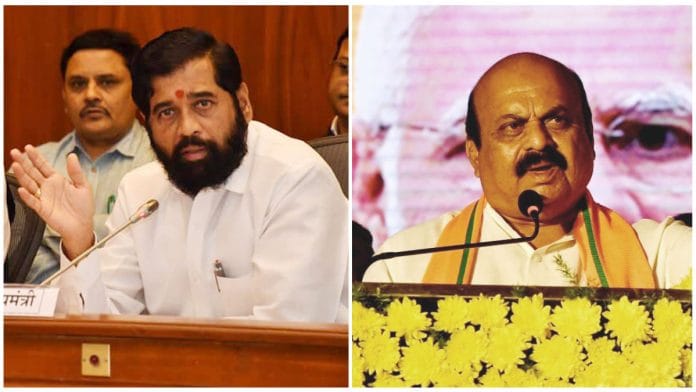Bengaluru/Mumbai: A festering inter-state dispute has flared up again after Maharashtra Chief Minister Eknath Shinde promised to extend a pension scheme to freedom fighters in Marathi-speaking border villages in Karnataka and announced several other measures.
The Basavaraj Bommai-led Karnataka government responded by announcing special grants for the development of Kannada schools in Maharashtra as well as announcing pension for those involved in ‘Ekikaran’ (unification) movement of Kannada-speaking areas.
“The border row has become a political tool in Maharashtra and any party which is in power will raise this issue for political purposes. But they have not been successful yet and (neither) in the future. We are capable of protecting the borders of Karnataka and have taken steps. We have worked together when it comes to land, language and water of Karnataka and have fought jointly,” Bommai said on Tuesday, demonstrating his commitment to “nela, jala, bhashe” (land, water and language) in the poll-bound state
The one-upmanship between the two states comes at a time when the Supreme Court is expected to hear the border dispute shortly. In September, the apex court listed the matter to be heard from 23 November but the hearing was delayed.
The new round of confrontations puts the Bharatiya Janata Party (BJP) on a sticky wicket as it is in power in Karnataka and has formed the government as part of an alliance with the Shinde faction of Shiv Sena in Maharashtra.
Maharashtra, which stakes claims over 800 villages like Bidar, Balki, Nippani, and Karwar, maintains that they be returned to its fold as Marathi speakers outnumber Kannadigas there.
Shinde first rejiiged a high-power committee on the border dispute and appointed himself as the panel chairman. Union Minister Narayan Rane, Deputy CM Devendra Fadnavis, Nationalist Congress Party (NCP) president Sharad Pawar and former Congress CM Prithviraj Chavan are among the members of this newly re-organised panel.
Formed in 2014 when a Congress-Nationalist Congress Party (NCP) government was in power, the panel was reorganised earlier twice by the Uddhav Thackeray-led Maha Vikas Aghadi (MVA) government in 2020 and 2022.
The demand to annex Marathi-speaking border areas of Karnataka with Maharashtra was one of the primary agendas of the Bal Thackeray-led Shiv Sena, which led to many violent protests over the issue in the past. The MVA government had strengthened the state’s Maharashtra-Karnataka border cell to advise in the ongoing legal battle as well as launch books and hold conferences on the issue.
On Monday, Shinde appointed cabinet ministers Chandrakant Patil and Shambhuraj Desai to oversee Maharashtra’s legal fight over the issue in the Supreme Court.
Apart from announcing the pension scheme in border areas, Shinde said his government will also take steps to extend the Mahatma Phule Jan Arogya Yojana to disputed areas.
“The state government will fight in the Supreme Court and make all efforts to include Marathi-speaking areas like Belgaum, Karwar and Nipani in Maharashtra,” Deputy CM Devendra Fadnavis said in Nagpur Wednesday, adding that there is no enmity between the two states and that it is just a legal issue.
Also Read: BJP eyes Vokkaliga votes with Kempegowda statue, but here’s why Bengaluru may not owe him origin
Genesis of the dispute
After the reorganisation of states in 1956, Belagavi and several other regions, which were part of the erstwhile Bombay presidency, became part of the Mysore state (later renamed as Karnataka in 1973). Maharashtra had challenged the decision, saying there was a higher proportion of Marathi speakers in these regions.
The Centre then formed the Mahajan Commission in October 1966 following which the panel submitted its report in August 1967. While 264 villages were proposed to be transferred to Maharashtra, the report suggested Belgaum (now known as Belagavi) and 247 villages remain with Karnataka. In 2004, Maharashtra moved the Supreme Court in 2004 to resolve the border dispute.
“It is a long-pending dispute. Maharashtra has filed the suit in which it is claiming a large number of villages, including Belagavi. The Mahajan panel was appointed on its insistence and the report was submitted to Parliament. Karnataka agreed to the report but Maharashtra went to the court again. That suit itself is not maintainable, is our main contention,” Maruti B. Zirali, an advocate who is part of Karnataka legal team, told The Print.
In Karnataka, the Bommai government cannot afford to take a soft approach on the border row especially as Winter session of the assembly is beginning from 19 December in Belagavi, the epicentre of the dispute. The southern state will go to the polls next year, and the BJP’s strength comes from the Kittur-Karnataka region (formerly Mumbai-Karnataka).
In 2012, the Suvarna Vidhana Soudha was inaugurated in Belagavi as a second power centre after Bengaluru to reassert Karnataka’s claim over the region as well as to address problems of its northern districts.
Activists allege that the Karnataka government has not taken an active role in the issue compared to its counterparts in Maharashtra. “One, there is no border in-charge minister. There is no high-powered committee and a border protection committee has not had even one meeting in the last three years,” Belagavi Kannada Organisations’ Action Committee convener Ashok Chandargi said.
“There is one more very important point. What is the role of the union government in the Supreme Court because they are respondent number one (in the suit filed by Maharashtra)?” he contended.
The Modi government had approved the change of name from Belgaum to Belagavi in 2014 despite protests from Maharashtra.
(Edited by Tony Rai)
Also Read: 530-page book, conference, app — how Uddhav govt is reviving age-old border row with Karnataka






